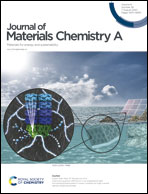Highly efficient overall water splitting over a porous interconnected network by nickel cobalt oxysulfide interfacial assembled Cu@Cu2S nanowires†
Abstract
The development of highly efficient electrocatalysts for simultaneous evolution of hydrogen and oxygen is a vital concern in water splitting. In this study, a novel catalyst derived from a porous interconnected network of nickel cobalt oxysulfide interfacial assembled Cu@Cu2S nanowires was rationally designed. It was recognized that the formation of multi-integrated active centers and a higher number of active sites, together with an adjusted adsorption energy towards reactants caused by the modulated surface and crystalline distortion of the NiCo oxide layer due to S insertion synergistically promoted both HER and OER. In addition, such 3D innovative core–shell structure effectively fine-tuned conductive properties and maximized interfacial contact to improve charge/mass transfer, thereby boosting catalytic activity and durability towards hydrogen and oxygen evolution. The catalyst only required an overpotential of 203 mV to achieve a current response of 20 mA cm−2 for the HER and 295 mV to reach 50 mA cm−2 for the OER in 1.0 M KOH medium. A developed electrolyzer enabled a small cell voltage of 1.61 V at 20 mA cm−2 without performance decay upon long-term operation. This result suggested an exciting prospect for developing new bifunctional electrocatalysts, which could effectively accelerate both hydrogen and oxygen evolution for water splitting applications.



 Please wait while we load your content...
Please wait while we load your content...